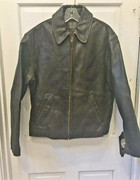I just bought a pretty decent look alike of the Menlo on ebay for about 60 bucks. Do you guys think its a decent budget alternative?

Now once I have this in my possession how do I get it to look as distressed as the Menlo? Any recommendations? Thanks
Comments
You need to go in a little harder on the areas which would naturally get more wear and tear, such as the top of the pockets, the cuffs, around the neck and the belt area; and go in a little easier on the broader swathes such as the front and back. I'm sure there are tutorials on YouTube which would give some pointers. Good luck!
If you wanna add some wrinkle character, sleep in it for a while and store it wadded up in a cotton pillowcase.
Would you recommend using 70% rubbing alcohol and sandpaper on it? Or toss it in the washer then the dryer on no heat?
Yes but be careful to not overuse it or dying will disappear.....
The alcohol/acetone technique is typically used to reduce "shine" on brand new, undistressed leathers. This jacket probably doesn't qualify. As has been mentioned, chemicals can remove too much dye on a pre-distressed jacket.
Fine grit sandpaper can be used sparingly on areas which would wear naturally (elbows, seams, back, etc.). Stay away from stitching.
I'd first wear it in the shower, wear it indoors for a while thereafter to induce some natural creasing and let it hang dry. Try the washer (gentle cycle, cold water) and no-heat dryer to take it further if desired.
My concern with this jacket is that since it's pre-distressed, the surface pores will already be open and could be "over-receptive" to further artificial distressing. So proceed with caution.
Good luck and post pics!
Thanks for the info and I will definitely post pics. When you say fine grit sandpaper. Do you mean 1500, 2000, etc?
I’m not sure of the grit number, but the finest you can possibly source to simulate natural abrasion from wearing the jacket for years. Then you’ll want to proceed very lightly and slowly so as to not overdo it. Anything too coarse will leave visible lines in the leather, which just makes it look like it was dragged across a parking lot.
2000 sandpaper seems great. You can begin with a higher grain (3000, 4000...) and lower the grain to the finish you like. Also, you can wet sand.....it will be more gentle for the leather !!!
What do you think of #0000 steel wool?
You can see the J.Crew tag inside the jacket in your picture